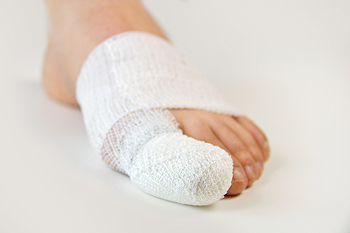
Dr. Kenneth Rosenthal
Dr. Jonathan C. O’Quinn
Dr. Michael J. Price

Dr. Kenneth Rosenthal
Dr. Jonathan C. O’Quinn
Dr. Michael J. Price

Juvenile plantar dermatosis is a common and chronic dry skin condition of the feet that usually affects pre-adolescent children between the ages of three and 14 years. It is also known as atopic winter feet and forefoot dermatitis. This condition affects boys slightly more often than girls. It is rarely seen in adults but can persist into adulthood. Juvenile plantar dermatosis can be caused by repetitive frictional movements, the occlusive effect of wearing covered footwear (particularly synthetic shoes), excessive sweating, genetic sensitivities, or warm or cool climate changes. This problem is usually visible on the weight-bearing areas of the soles, ball of the big toes, and forefoot of the foot with itchy, sore, shiny, red skin that has a glazed appearance and a loss of the epidermal ridge pattern. Typically, both feet are affected. The most common complication of juvenile plantar dermatosis is painful cracks and fissures, which may become infected. This affliction is sometimes confused with other skin conditions, such as atopic eczema, plantar psoriasis, or tinea pedis. Wearing well-fitting leather shoes, two or more pairs of cotton and wool socks, and changing socks regularly will help reduce friction. Moisturizing the feet will help prevent dry skin. Resting the feet to allow any fissures to heal will help as well. If your child is experiencing problems with the skin of their feet, consult with a podiatrist who can diagnose any conditions and provide options for treatment.
The health of a child’s feet is vital to their overall well-being. If you have any questions regarding foot health, contact one of our podiatrists of Eastern Carolina Foot & Ankle Specialists. Our doctors can provide the care you need to keep you pain-free and on your feet.
Tips for Keeping Children's Feet Healthy
If you have any questions, please feel free to contact our office located in Greenville, NC . We offer the newest diagnostic and treatment technologies for all your foot care needs.

Individuals who struggle with obesity are sometimes more susceptible to experiencing problematic foot conditions. For example, some obese individuals are more likely to develop flat feet because their higher body weight makes them exert more pressure on their feet when standing. Therefore, if you suffer from obesity, it might be a good idea to take extra care of the health of your feet. Obese individuals ought to be particularly mindful of ankle sprains because not only does obesity increase your risk of spraining the ankle, it also might make recovery from such an injury more difficult and prolonged. Ankle sprains occur when the foot turns awkwardly and tears or strains the ligaments surrounding the ankle. Obesity also heightens your risk of developing a sprained ankle because the extra body weight increases your instability and reduces balance control, among other things. When recovering from an ankle sprain, obese individuals are also particularly vulnerable. The joints affected by an ankle sprain may take a longer time to heal post-injury in obese individuals because of the detrimental effects obesity has on ankle joint function. Therefore, if you are obese and are trying to recover from an ankle sprain, you might need extra help in managing your symptoms to heal the injury. Contact a podiatrist for any questions you might have about how obesity affects ankle sprains.
Obesity has become very problematic at this point in time and can have extremely negative effects on the feet. If you’re an obese individual and are concerned about your feet, contact one of our podiatrists from Eastern Carolina Foot & Ankle Specialists. Our doctors can provide the care you need to keep you pain-free and on your feet.
Obesity and Your Feet
Since your feet are what support your entire weight when standing, any additional weight can result in pain and swelling. Being overweight is one of the main contributors to foot complications.
Problems & Complications
Extra Weight – Even putting on just a few extra pounds could create serious complications for your feet. As your weight increases, your balance and body will shift, creating new stresses on your feet. This uneven weight distribution can cause pain, even while doing the simplest tasks, such as walking.
Diabetes – People who are overweight are at serious risk of developing type-2 diabetes, which has a drastic impact on the health of your feet. As you get older, your diabetes might worsen, which could lead to loss of feeling in your feet, sores, and bruises. You could also become more prone to various infections.
Plantar fasciitis – Pressure and stress that is placed on muscles, joints, and tendons can trigger plantar fasciitis, which is an inflammation of tissue that forms along the bottom of the foot.
If you have any questions please feel free to contact our office located in Greenville, NC . We offer the newest diagnostic and treatment technologies for all your foot and ankle needs.

A podiatrist is a foot doctor who treats the feet and ankles and any of their connecting parts. This type of doctor will have the initials "DPM" standing for Doctor of Podiatric Medicine following their name. A podiatrist must complete four years of study at a podiatric medical school followed by at least three years of residency training at a hospital or clinic. After passing the required exams, a podiatrist will be certified by the American Board of Podiatric Medicine and may desire to undertake further training to specialize in a particular area of foot health. A podiatrist is licensed to practice in the state that they work in, and like all other doctors, they must renew their licenses every few years and keep up to date with training. Most podiatrists treat general foot conditions as would a general practitioner unless they specialize in a particular area like surgery, wound care, or pediatrics. If you experience any pain in your feet or ankles, or if you want to learn about the best types of shoes that should be worn, it is suggested that you consult with a podiatrist for diagnosis, treatment, and general knowledge.
If you are dealing with pain in your feet and ankles, you may want to seek help from a podiatrist. Feel free to contact one of our podiatrists from Eastern Carolina Foot & Ankle Specialists. Our doctors can provide the care you need to keep you pain-free and on your feet.
What Is a Podiatrist?
A podiatrist is a doctor of podiatric medicine who diagnoses and treats conditions of the foot, ankle, and related structures of the leg. Your podiatrist may specialize in a certain field such as sports medicine, wound care, pediatrics, and diabetic care. Podiatrists have the ability to become board certified through training, clinical experience, and then taking an exam.
What Do Podiatrists Do?
On a daily basis, a podiatrist may perform the following activities:
It is very important that you take care of your feet. It’s easy to take having healthy feet for granted, however foot problems tend to be among the most common health conditions. Podiatrists can help diagnose and treat a variety of feet related conditions, so it is crucial that you visit one if you need assistance.
If you have any questions please feel free to contact our office located in Greenville, NC . We offer the newest diagnostic and treatment technologies for all your foot and ankle needs.

Sore feet can be common as the aging process occurs. It is beneficial to frequently perform simple foot stretches and exercises, and this can promote increased flexibility and range of motion. An effective stretch is done by sitting in a chair, and while keeping the feet flat on the floor. Start by raising the toes off the floor several times, followed by the heels, and hold for a few seconds. The big toe can be stretched by bringing one foot up to rest on the knee of the other leg, and gently stretching the big toe up and down. This can help to maintain a wide range of motion in the toe, in addition to relieving pain from wearing tight shoes. All the toes can receive an adequate stretch when a toe splay is practiced. This is accomplished by keeping the heel on the ground, and moving all the toes at once up and down. There are many additional benefits to stretching the feet, and it is suggested that you speak with a podiatrist who can guide you toward the right stretching techniques.
Why Stretching Is Important for Your Feet
Stretching the feet is a great way to prevent injuries. If you have any concerns with your feet consult with one of our podiatrists from Eastern Carolina Foot & Ankle Specialists. Our doctors will assess your condition and provide you with quality foot and ankle treatment.
Stretching the Feet
Stretching the muscles in the foot is an important part in any physical activity. Feet that are tight can lead to less flexibility and make you more prone to injury. One of the most common forms of foot pain, plantar fasciitis, can be stretched out to help ease the pain. Stretching can not only ease pain from plantar fasciitis but also prevent it as well. However, it is important to see a podiatrist first to determine if stretching is right for you. Podiatrists can also recommend other ways to stretch your feet. Once you know whether stretching is right for you, here are some excellent stretches you can do.
It is best to go easy when first stretching your foot and work your way up. If your foot starts hurting, stop exercising to ice and rest the foot. It is advised that you then see a podiatrist for help.
If you have any questions, please feel free to contact our office located in Greenville, NC . We offer the newest diagnostic and treatment technologies for all your foot care needs.

While toe injuries are usually not serious, they can seriously impede the progress of an athlete. If you participate in sports, it is critical that you wear the right shoes for the sport that you participate in. Watch for toe fractures by tending to the severity of the pain felt and possible swelling, looking for deformities of the toe or toenail and other possible wounds. If a toe is sprained and not broken, it can be buddy taped to the toe next to it to reduce pain and speed recovery. Doing some basic motion exercises might also help with blood flow, and reduce pain and stiffness. Toe injuries left untreated or unaddressed for too long could lead to stiffness, arthritis, or permanent pain long-term. Toe injuries sustained during sports that involve fractures or do not heal after resting for a period of time should be seen by a podiatrist for proper diagnosis and guidance in treatment.
Ankle and foot injuries are common among athletes and in many sports. They can be caused by several problems and may be potentially serious. If you are feeling pain or think you were injured in a sporting event or when exercising, consult with one of our podiatrists from Eastern Carolina Foot & Ankle Specialists. Our doctors will assess your condition and provide you with quality foot and ankle treatment.
Common Injuries
The most common injuries that occur in sporting activities include:
Symptoms
Symptoms vary depending upon the injury and in some cases, there may be no symptoms at all. However, in most cases, some form of symptom is experienced. Pain, aching, burning, bruising, tenderness, tightness or stiffness, sensation loss, difficulty moving, and swelling are the most common symptoms.
Treatment
Just as symptoms vary depending upon the injury, so do treatment options. A common treatment method is known as the RICE method. This method involves rest, applying ice, compression and elevating the afflicted foot or ankle. If the injury appears to be more serious, surgery might be required, such as arthroscopic or reconstructive surgery. Lastly, rehabilitation or therapy might be needed to gain full functionality in the afflicted area. Any discomfort experienced by an athlete must be evaluated by a licensed, reputable medical professional.
If you have any questions, please feel free to contact our office located in Greenville, NC . We offer the newest diagnostic and treatment technologies for all your foot care needs.